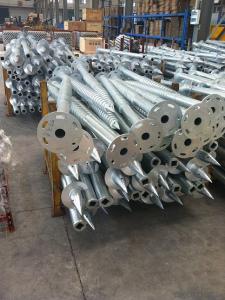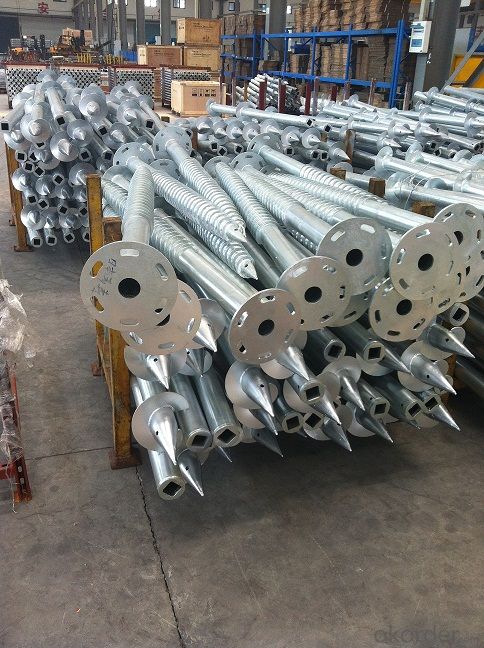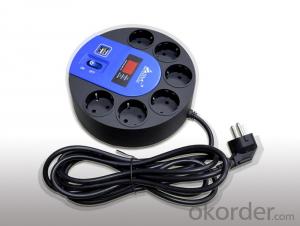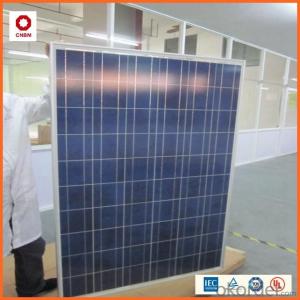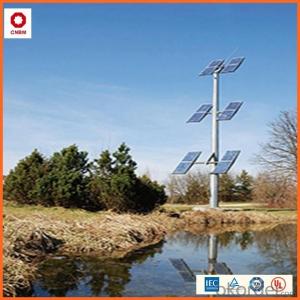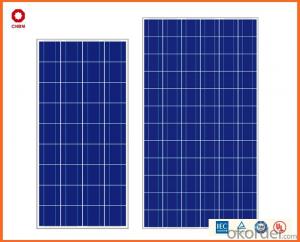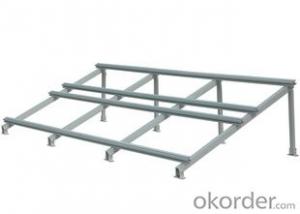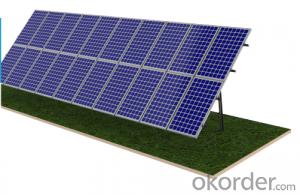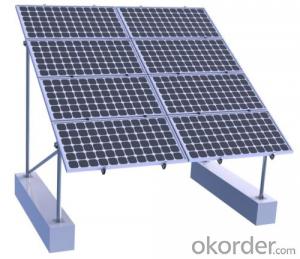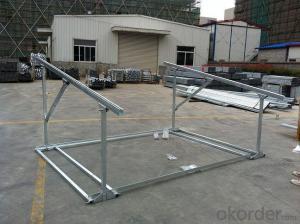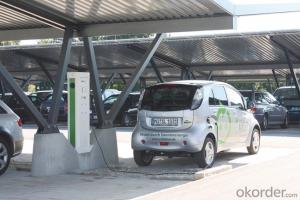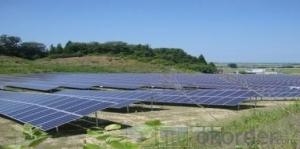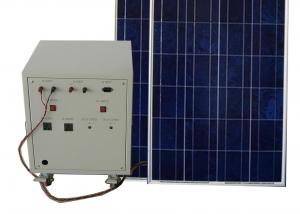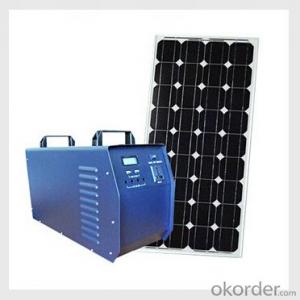Pv Max Solar Energy Systems - Ground System Solar Mounting System
- Loading Port:
- China Main Port
- Payment Terms:
- TT OR LC
- Min Order Qty:
- -
- Supply Capability:
- -
OKorder Service Pledge
OKorder Financial Service
You Might Also Like
Packaging & Delivery
Packaging Detail:Normal package seaworthy
Delivery Detail:15 days
Specifications
Easy installation Competitive price TUV&SGS test report & CSA certification 15-warranty
Specifications
1) Super smooth beautiful appearance,outstanding quality,large supply.
2) Available in customized surface finishes.
3) Well machined,for example,cutting,drilling and milling with excellent tolerance.
4) Meet with customer’s designs and supply you best price.
5)Usages:Supply for solar panel modules.
Technical characteristics
Installation site:
ground,hillside,and grassland
Installation angle
it is based on customers’ requirements
Installation height
it is basedon customers’ requirements
Solar panel type; with or without frame
Components arrangement :horizontal or vertical
Support track
aluminum alloy extrusion
Quality warranty
15 years
Advantages
1)Quick installation: with high degree of pre-installed rate, the system could be easily installed by using galvanized carbon steel rails for PV Stent, and specially designed connection parts of the PV bracket, which could reduce installation time and cost greatly.
2)Offer unmatched durability: with all structural components comprised of high class stainless steel and anodized aluminum alloy, it is designed for 25 years service life and backed by 15 years warranty.
3)Stand up to extreme weather: The SuninTek solar mount is designed to stand up to the extreme weather complied with the AS/NZ 1170 and other international structure load standard by the skilled engineer. The main support components also have been tested to guarantee its structure and load-carrying capacity.
4)Provide broad installation flexibility: These systems accommodate most commercially available framed solar panels , and they can scale easily from small to large, multi-megawatt installations.
5)Diversified Application: The PV mounting system produced can be adopted by various types of PV cells panels which you can find in the market. It can serve for both mini solar power system and huge plant with megawatt capability.
Main features
1. Installation cost savings.
2. Save installation time.
3. Increase the mechanical strength of solar energy mounting to ensure that wind requirements.
4. The outdoor for installation of solar energy.
5. Length can be customized according to customers.
6. Service life of up to 25 years.
7. Products through the international certification.
8. Stent material composition of the galvanized steel and aluminum.
9. 15 years system and structural guarantee.
10.Flexible post spacing withstands different wind & snow loads.
11. High quality material in Aluminium 6005-T5 and SUS 304.
12.Screws and nuts go with every components needed.
13.Mechanical calculation and reliability tested to ensure highest product quality.
- Q: How do solar energy systems impact energy efficiency measures?
- Solar energy systems can significantly impact energy efficiency measures by reducing the reliance on traditional energy sources. By harnessing the sun's energy, solar systems provide a clean and renewable source of power, which in turn reduces the consumption of fossil fuels. This results in decreased greenhouse gas emissions and a more sustainable energy supply. Additionally, solar energy systems often encourage the adoption of energy-efficient practices, such as implementing energy-saving appliances or improving insulation, to maximize the benefits of solar power. Overall, solar energy systems play a crucial role in enhancing energy efficiency measures and promoting a greener and more sustainable future.
- Q: Can solar energy systems be used for powering electric vehicle solar charging canopies?
- Yes, solar energy systems can be used to power electric vehicle solar charging canopies. Solar panels can be installed on the canopy structure to harness sunlight and convert it into electricity. This electricity can then be used to charge the batteries of electric vehicles parked under the canopy. This setup not only utilizes clean and renewable energy from the sun but also provides a convenient and sustainable charging solution for electric vehicles. Additionally, excess energy generated by the solar panels can be stored in batteries or directed back to the grid, further enhancing the environmental benefits of this system.
- Q: How do solar energy systems impact wildlife?
- Solar energy systems can have both positive and negative impacts on wildlife. On the positive side, they offer renewable energy, reducing the need for fossil fuels and reducing air and water pollution. Additionally, solar panels can provide shelter and shade for certain species. However, there are also negative impacts to consider. Large-scale solar projects can lead to habitat destruction, displacement of wildlife, and disruption of migration patterns. Additionally, the glare from solar panels can disorient birds and insects. To minimize these impacts, it is crucial to carefully plan and design solar projects, considering the needs and habitats of local wildlife.
- Q: What is the role of surge protectors in a solar energy system?
- Surge protectors play a crucial role in a solar energy system by safeguarding the system against power surges and voltage spikes. Solar energy systems generate electricity through photovoltaic panels, which convert sunlight into usable energy. However, electrical disturbances such as lightning strikes, grid fluctuations, or equipment malfunctions can cause sudden voltage surges that can potentially damage the solar panels, inverters, and other components of the system. A surge protector serves as a protective barrier by diverting excess voltage away from the system, preventing it from reaching and potentially damaging sensitive equipment. It works by monitoring the electrical current flowing through the system and automatically redirecting any excess voltage to a grounding wire or dissipating it safely. This helps to maintain a stable and consistent flow of electricity, ensuring the longevity and performance of the solar energy system. In addition to protecting against power surges, surge protectors also mitigate the risk of electrical fires that can occur due to overvoltage situations. By preventing excessive voltage from reaching critical components, surge protectors significantly reduce the chances of electrical failures and potential fire hazards. Furthermore, surge protectors enhance the overall safety of the solar energy system by providing a layer of protection for the homeowners and professionals working on the system. They create a reliable barrier that prevents electrical shocks by diverting high voltages away from the system and grounding them safely. Overall, surge protectors are an essential component in a solar energy system as they protect against power surges, voltage spikes, and potential electrical hazards. By ensuring the system's integrity and safety, surge protectors contribute to the optimal performance and longevity of the solar energy system.
- Q: Can solar energy systems be used in all locations?
- Solar energy systems have the potential to be utilized in a variety of locations, although their effectiveness and efficiency may fluctuate depending on the local climate and geography. Generally, solar panels require ample sunlight to generate electricity, making them most suitable for areas with abundant sunshine and minimal obstruction. However, advancements in solar technology have greatly enhanced their efficiency, broadening the range of locations where solar energy systems can be employed. Regions with high levels of solar radiation, such as deserts or tropical areas, can generate substantial energy throughout the year using solar panels. These areas are particularly well-suited for solar energy systems due to their increased exposure to sunlight, resulting in higher energy production and faster return on investment. Conversely, locations characterized by frequent cloud cover or extended periods of darkness, like certain northern regions or areas with dense tree cover, may experience reduced solar energy production. Nevertheless, this does not render solar energy systems unusable in these areas. In fact, solar panels can still generate electricity on cloudy days, albeit at a lower efficiency. Furthermore, innovative technologies such as concentrated solar power (CSP) or solar tracking systems can improve energy production in areas with limited sunshine. Additionally, solar energy systems can be tailored to accommodate various geographical conditions. For example, in areas where space is limited, rooftop solar panels can be installed on buildings. On the other hand, ground-mounted solar panels or solar farms can be deployed in locations with ample open spaces. Furthermore, floating solar panels can be installed on bodies of water, effectively utilizing previously unused spaces like reservoirs or lakes. It is important to note that while solar energy systems can be deployed in most locations, their suitability and economic viability should be evaluated on a case-by-case basis. Factors such as local solar resources, electricity demand, installation costs, and government incentives or policies must be taken into consideration to determine the feasibility of implementing solar energy systems in a specific location.
- Q: What are the different types of solar panels used in solar energy systems?
- The different types of solar panels used in solar energy systems include monocrystalline, polycrystalline, thin-film, and bifacial panels. Monocrystalline panels are made from a single crystal structure, making them highly efficient but more expensive. Polycrystalline panels are made from multiple crystal structures, offering a lower cost but slightly lower efficiency. Thin-film panels use layers of semiconductor materials and are flexible, lightweight, and less efficient. Bifacial panels can absorb sunlight from both sides, increasing their overall energy generation.
- Q: What is the efficiency of solar energy systems?
- The efficiency of solar energy systems refers to the amount of sunlight that is converted into usable energy. It is typically measured as a percentage of the total sunlight that strikes the surface of the solar panels and is converted into electricity. The efficiency of solar energy systems can vary depending on various factors such as the type of solar panel technology used, the quality of the panels, the location and orientation of the panels, and environmental conditions. On average, the efficiency of solar panels available in the market today ranges from around 15% to 20%. However, there are more advanced solar panel technologies, such as monocrystalline and polycrystalline panels, that can achieve higher efficiencies, up to 25%. It is worth noting that the efficiency of solar panels is constantly improving due to advancements in technology and research. Scientists and engineers are continuously working to develop more efficient solar cells and panel designs to harness more energy from the sun. Furthermore, it is important to consider that the efficiency of solar energy systems is not the only factor to consider when evaluating their overall performance. Other factors like the cost of installation, maintenance requirements, and the availability of sunlight in a particular area are also important considerations when determining the effectiveness and suitability of solar energy systems.
- Q: Can solar energy systems be installed in areas with high wind speeds?
- Yes, solar energy systems can be installed in areas with high wind speeds. However, it is important to ensure that the solar panels and supporting structures are designed and installed to withstand the specific wind conditions in the area. This may involve using stronger materials, anchoring systems, or tilt mechanisms to minimize the risk of damage from high winds.
- Q: Can solar energy systems be used for powering industrial processes?
- Yes, solar energy systems can certainly be used for powering industrial processes. Solar power has gained popularity in recent years as a sustainable and renewable energy source. Industrial processes often require a significant amount of energy, and solar power can be harnessed to meet these demands. There are several ways in which solar energy systems can be utilized for industrial processes. One common method is through the installation of solar photovoltaic (PV) panels. These panels convert sunlight directly into electricity, which can then be used to power various industrial machinery and equipment. By integrating solar PV systems into the existing infrastructure, industries can reduce their dependence on traditional fossil fuels and lower their carbon footprint. In addition to generating electricity, solar thermal systems can also be used to power industrial processes. Solar thermal technology uses the sun's heat to produce steam, which can then drive turbines or provide direct heat for industrial applications. This method is particularly useful for industries that require high-temperature processes, such as manufacturing, chemical production, or food processing. Implementing solar energy systems for industrial processes offers numerous benefits. Firstly, it helps to reduce greenhouse gas emissions and combat climate change. Solar power is a clean energy source that releases no harmful pollutants or greenhouse gases during operation. By transitioning to solar energy, industries can contribute to a more sustainable and environmentally friendly future. Moreover, utilizing solar power can help industries save on energy costs in the long run. While the initial investment for installing solar energy systems may be high, the operational costs are significantly lower compared to traditional energy sources. Once the systems are in place, industries can benefit from reduced electricity bills and even generate excess energy that can be sold back to the grid. Lastly, solar energy systems offer a reliable and resilient power source. They can operate even in remote areas or during power outages, ensuring uninterrupted production processes. Additionally, solar panels have a long lifespan and require minimal maintenance, making them a viable long-term solution for industrial power needs. In conclusion, solar energy systems can indeed be used for powering industrial processes. With the advancements in solar technology and the increasing focus on sustainability, more and more industries are embracing solar power to meet their energy demands. By harnessing the sun's energy, industries can reduce their environmental impact, save on energy costs, and ensure a reliable and resilient power supply for their industrial processes.
- Q: Are there any tax benefits for installing a solar energy system?
- Installing a solar energy system comes with numerous tax benefits. One significant benefit is the federal investment tax credit (ITC), which permits individuals and businesses to deduct a percentage of their solar energy system's cost from their federal taxes. As of 2021, the ITC offers a 26% tax credit for residential and commercial systems. Moreover, some states provide their own tax incentives for solar energy installations. These incentives may encompass exemptions from property taxes, sales taxes, or state tax credits. The availability and extent of these incentives differ from state to state, necessitating thorough research into the specific incentives offered in your region. Furthermore, the installation of a solar energy system can enhance your property's value. Numerous studies have demonstrated that homes equipped with solar panels yield a higher selling price compared to those without. This boost in property value can yield long-term financial advantages. To fully comprehend and capitalize on all the tax benefits associated with installing a solar energy system, it is advisable to consult a tax professional or a solar energy expert.
Send your message to us
Pv Max Solar Energy Systems - Ground System Solar Mounting System
- Loading Port:
- China Main Port
- Payment Terms:
- TT OR LC
- Min Order Qty:
- -
- Supply Capability:
- -
OKorder Service Pledge
OKorder Financial Service
Similar products
Hot products
Hot Searches
Related keywords
